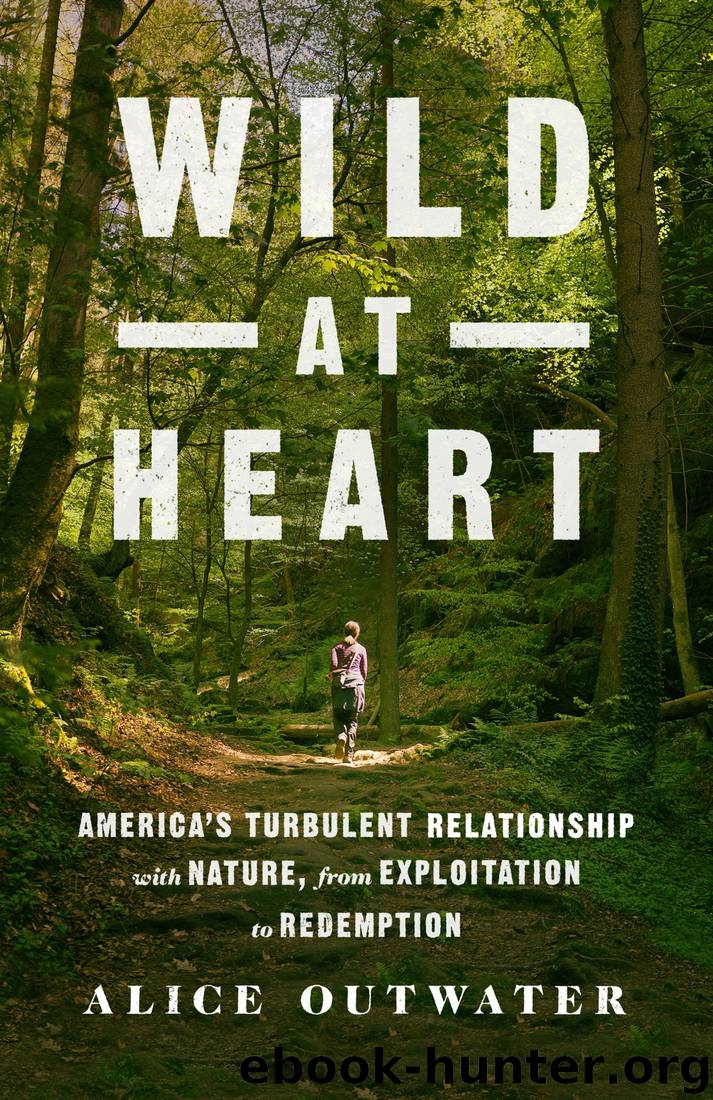Wild at Heart: America's Turbulent Relationship With Nature, From Exploitation to Redemption by Alice Outwater

Author:Alice Outwater
Language: eng
Format: epub
Publisher: St. Martin's Press
Published: 2019-04-01T23:00:00+00:00
9
Rearranging Nature
Water is both reusable and infinitely divisible. It can be shared any way you want, and recycled again and again. When you look at how easily this resource is moved and measured, it seems unconscionable that there isn’t water for wildlife. The history of water rights allows for my agricultural water and your municipal water, but a fish that lives in a stream has no right to water at all.
Nature relies on the water provided by rainfall and snowpack, while agriculture requires specific inputs of water at certain times during a plant’s life cycle. There is too little rain in most western states to support domesticated plants and animals, so nearly every lake, river, stream, pond, and underground aquifer is diverted into a network of ditch systems. Without irrigation ditches, the crops and livestock in most of the western United States would not survive.
Laws determine how we share water, and water laws vary from state to state. East of the Mississippi River there is generally enough rainfall to grow crops, and surface water can only be used by the people living next to a river, lake, or pond. This riparian (“riverside”) system requires that a landowner who diverts water put it to reasonable use for a household, livestock, gardens, irrigation, industry, or recreation. Most riparian states use permits to make sure that upstream landowners’ water use doesn’t affect the rights of downstream landowners.
West of the Mississippi, there is generally too little rainfall for unirrigated agriculture. Water laws are critical in this region, but the existing legal system is based on an accident of history. Miners settled the region first, and they needed water to develop their mining claims. Their fierce competition for this scarce resource was ultimately settled with money, and a set of laws that favored the mine owners. Those laws have endured, resulting in a deeply irrational system.
My Jack London–ish vision of mining includes men wearing Levi’s panning for gold nuggets in gravel-bottomed rivers and men wielding pickaxes in underground tunnels to break up ore. These Norman Rockwell versions of placer and hard rock mining had disappeared by the early 1860s, when industrial-scaled mining processes funded by great companies bought out the small operators. Industrial placer and hard rock mining both depended on poorly paid workers and vast quantities of water.
Placer miners (from placel, Spanish for “sandbank”) remove minerals from the fine-grained mud, silt, and sand deposited in the streambed by flowing water. Rather than sifting gravel with a pan, cup by cup, hydraulic mining—hydraulicking—uses high-pressure water jets to sluice alluvium by the cubic yard.
A holding pond is built above the stream, and a system of hoses and nozzles shoots high-pressure water at the streambed to wash the mineral-bearing deposits—along with the hillside—down and through huge sluice boxes similar to wooden troughs with ridged bottoms that catch the gold. This process, where gravity separates the minerals from the slurry of water and sediment, dates back to Roman times. Hydraulicking was first used in California in 1853.
A placer deposit lies on the surface of the Earth and is easy to get to.
Download
This site does not store any files on its server. We only index and link to content provided by other sites. Please contact the content providers to delete copyright contents if any and email us, we'll remove relevant links or contents immediately.
The Lonely City by Olivia Laing(4768)
Animal Frequency by Melissa Alvarez(4428)
All Creatures Great and Small by James Herriot(4271)
Walking by Henry David Thoreau(3923)
Exit West by Mohsin Hamid(3795)
Origin Story: A Big History of Everything by David Christian(3666)
COSMOS by Carl Sagan(3589)
How to Read Water: Clues and Patterns from Puddles to the Sea (Natural Navigation) by Tristan Gooley(3433)
Hedgerow by John Wright(3317)
How to Read Nature by Tristan Gooley(3292)
The Inner Life of Animals by Peter Wohlleben(3285)
How to Do Nothing by Jenny Odell(3264)
Project Animal Farm: An Accidental Journey into the Secret World of Farming and the Truth About Our Food by Sonia Faruqi(3189)
Origin Story by David Christian(3170)
Water by Ian Miller(3155)
A Forest Journey by John Perlin(3043)
The Plant Messiah by Carlos Magdalena(2900)
A Wilder Time by William E. Glassley(2835)
Forests: A Very Short Introduction by Jaboury Ghazoul(2815)
